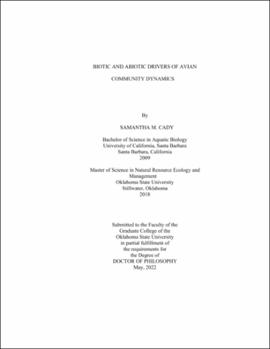| dc.contributor.advisor | Davis, Craig A. | |
| dc.contributor.author | Cady, Samantha M. | |
| dc.date.accessioned | 2023-03-23T20:30:18Z | |
| dc.date.available | 2023-03-23T20:30:18Z | |
| dc.date.issued | 2022-05 | |
| dc.identifier.uri | https://hdl.handle.net/11244/337159 | |
| dc.description.abstract | Birds are an imperiled taxon in North America and have experienced rapid and widespread decline in the most recent century. Here, we use both basic and applied approaches to better understand how bird communities function at regional and continental scales. Specifically, we used a half-century of continental-scale bird community data to quantify avian community variability across diverse biomes in North America, and compared the relative contributions of climate (both mean conditions and weather extremes) and species richness to avian community stability. Our results indicate that—despite disproportionately high attention to the diversity-stability concept in the literature—environmental conditions better explained community stability than the species richness of the community itself. Specifically, extreme heat and extremely low precipitation are associated with low community stability. Next, we investigated the spatial and temporal scaling relationships of a hypothesized mechanism of ecological stability, compensatory dynamics. Results indicate that community-level compensatory dynamics are generally rare, but also highly spatially scale-dependent (more prevalent at small scales). We also found strong evidence of synchronous bird species at large (decadal) temporal scales—that is, areas of long-term bird abundance declines of some species are less likely to experience concomitant abundance increases of other species. We also evaluated the response of northern bobwhite to drought conditions across two biomes. We found that bobwhite abundance significantly decreased in both biomes, but decline was more than twice as sharp in the Eastern Forest as it was the Great Plains. We also found that bobwhite declined with drought conditions in the Great Plains but had a positive association with drought in the Eastern Temperate Forest. Finally, we investigated the response of northern bobwhite to woody cover across two, proximal study areas and found markedly different resource selection patterns. Specifically, whether bobwhite selected for shrub cover and whether they strongly avoided trees, depended on the study site in focus. Additionally, the spatial scale of selection was nearly an order of magnitude different between the cover types. All four chapters highlight an important pattern: complexity appears to be the rule rather the exception in natural systems. | |
| dc.format | application/pdf | |
| dc.language | en_US | |
| dc.rights | Copyright is held by the author who has granted the Oklahoma State University Library the non-exclusive right to share this material in its institutional repository. Contact Digital Library Services at lib-dls@okstate.edu or 405-744-9161 for the permission policy on the use, reproduction or distribution of this material. | |
| dc.title | Biotic and abiotic drivers of avian community dynamics | |
| dc.contributor.committeeMember | Fuhlendorf, Samuel D. | |
| dc.contributor.committeeMember | Loss, Scott R. | |
| dc.contributor.committeeMember | Luttbeg, Barney | |
| osu.filename | Cady_okstate_0664D_17608.pdf | |
| osu.accesstype | Open Access | |
| dc.type.genre | Dissertation | |
| dc.type.material | Text | |
| dc.subject.keywords | birds | |
| dc.subject.keywords | climate change | |
| dc.subject.keywords | community ecology | |
| dc.subject.keywords | compensatory dynamics | |
| dc.subject.keywords | extreme weather | |
| dc.subject.keywords | stability | |
| thesis.degree.discipline | Natural Resources and Ecology Management | |
| thesis.degree.grantor | Oklahoma State University | |
